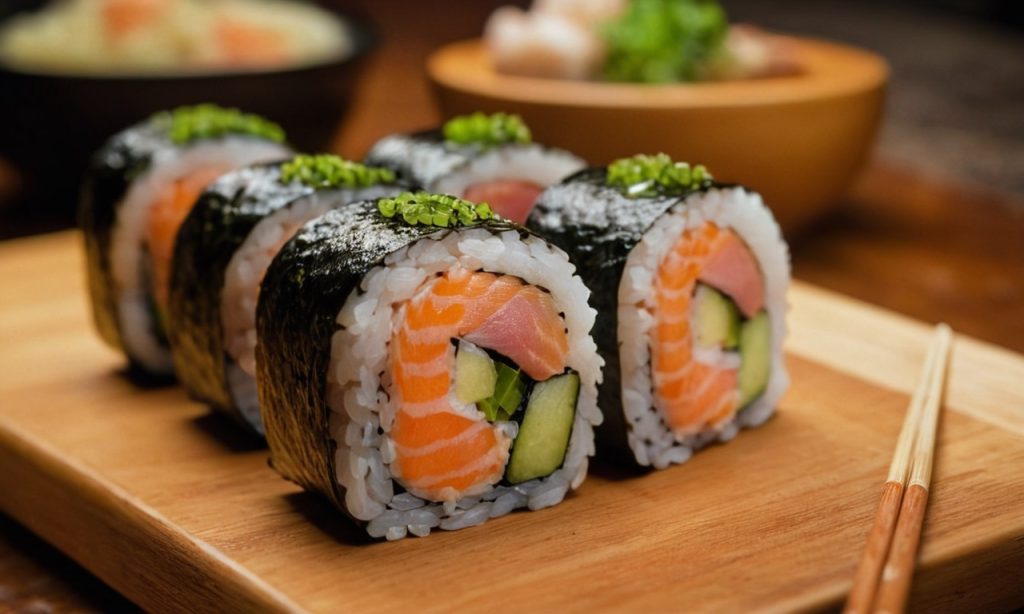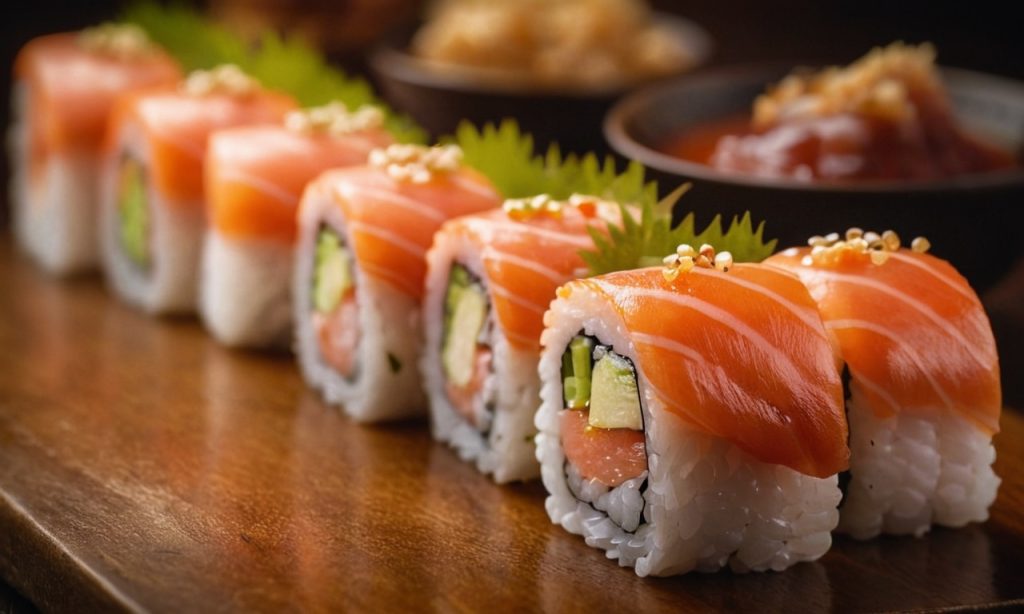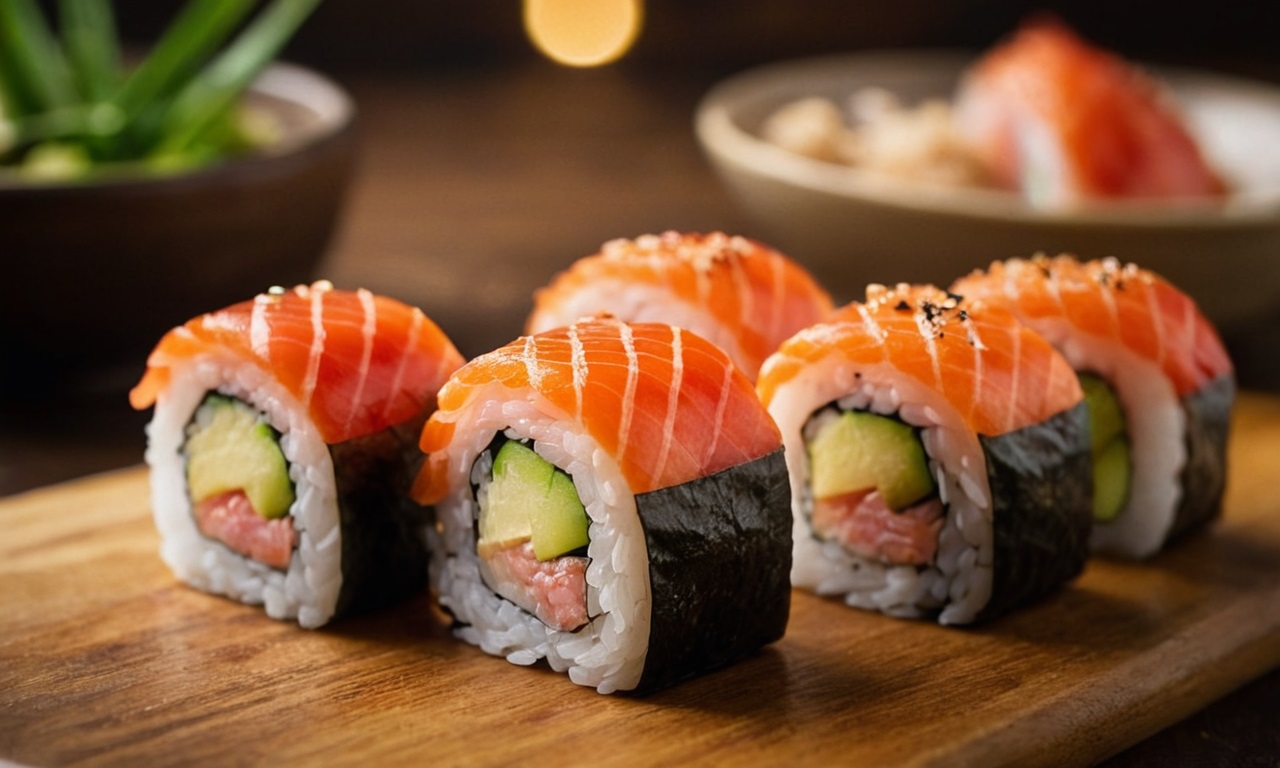Diving into the world of sushi, the salmon skin roll stands out as a crunchy, flavorful delight that has won the hearts of many. This article unravels the secrets behind this sushi gem, exploring its nutritional benefits, culinary versatility, and how it fits into sustainable eating practices. Whether you’re a sushi aficionado or a curious foodie, get ready to discover the world of salmon skin rolls, from traditional recipes to innovative culinary uses. Let’s embark on this tasty journey together, shall we?
Introduction to Salmon Skin Rolls

Salmon skin rolls are more than just a sushi staple; they are a testament to the creativity and sustainability in Japanese cuisine. Typically made by rolling crispy, seasoned salmon skin with rice and nori, these rolls offer a unique texture and flavor profile that sets them apart in the sushi world.
Exploring the Nutritional Benefits
The skin of the salmon, often overlooked, is a powerhouse of nutrients. Rich in Omega-3 fatty acids, it not only supports heart health but also contributes to glowing skin and improved brain function. The presence of various vitamins and minerals in the salmon skin enhances its nutritional profile, making salmon skin rolls a guilt-free indulgence.
Omega-3 Fatty Acids and Their Health Benefits
The Omega-3 fatty acids found in salmon skin are crucial for maintaining cardiovascular health and reducing inflammation. Regular consumption can lead to significant health benefits, making salmon skin rolls a smart choice for health-conscious individuals.
Vitamins and Minerals in Salmon Skin
Apart from Omega-3s, salmon skin is laden with essential nutrients like Vitamin D, B vitamins, and selenium. These contribute to bone health, energy production, and antioxidant defense, respectively, highlighting the nutritional value of salmon skin rolls.
Comparing Salmon Skin to Other Fish Skins
While many fish skins contain beneficial nutrients, salmon skin stands out due to its high fatty acid content and the presence of unique antioxidants. This comparison sheds light on why salmon skin rolls are not just a culinary treat but also a nutritional standout in the world of sushi.
In the realm of sushi, salmon skin rolls carve a niche for themselves, offering a blend of crunch, flavor, and nutrition. As we peel back the layers, it’s clear that this sushi variant is more than meets the eye, providing a delightful experience that caters to both taste and health.
Stay tuned as we delve deeper into the culinary uses of salmon skin in the upcoming section, where creativity meets tradition in the kitchen.
This part introduces readers to the salmon skin roll, highlighting its nutritional value and setting the stage for a deeper exploration of its culinary potential and sustainability aspects in the following sections.
Culinary Delights: Cooking with Salmon Skin
The culinary world has long celebrated salmon skin for its versatility and unique texture. Beyond sushi, there are myriad ways to incorporate this ingredient into dishes, showcasing its ability to transform a meal from ordinary to extraordinary.
Traditional Salmon Skin Rolls in Sushi
In the heart of traditional Japanese sushi, salmon skin rolls emerge as a beloved classic. Crispy salmon skin, with its smoky flavor and satisfying crunch, pairs perfectly with the subtle tang of sushi rice and the umami-rich nori. This harmonious blend of textures and flavors exemplifies the artistry of sushi-making, where every component plays a pivotal role.
Innovative Recipes Featuring Salmon Skin
Chefs and home cooks alike are getting creative with salmon skin, introducing it into a variety of dishes. From salmon skin chips as a crunchy snack to its use as a savory topping on salads, the possibilities are endless. These innovative recipes not only highlight the ingredient’s versatility but also contribute to a more sustainable approach to cooking by utilizing every part of the fish.
Tips for Crisping Salmon Skin to Perfection
Achieving that perfect crispiness in salmon skin is an art in itself. The key lies in proper preparation and cooking techniques. Start by patting the skin dry, seasoning it to your liking, and then pan-frying it skin-side down until it reaches the desired level of crispiness. This method ensures a delightful texture that enhances any dish it accompanies.
In the culinary realm, salmon skin offers a canvas for creativity, allowing chefs to experiment with flavors and textures. From its traditional role in sushi to its emergence in modern cuisine, salmon skin proves to be a versatile and nutritious ingredient that elevates any culinary creation.
As we move forward, we’ll explore the importance of sustainability and ethical considerations in sourcing salmon, ensuring that our culinary indulgences also align with environmentally conscious choices. Stay with us as we delve into the world of sustainable seafood in the next segment.
Sustainability and Ethical Sourcing of Salmon
Salmon skin rolls are delicious, but let’s not forget sustainability! Our seafood choices impact the environment, so considering where our salmon comes from is important.
The Importance of Choosing Sustainable Salmon
Sustainability in the context of salmon sourcing refers to practices that ensure the long-term viability of salmon populations and their natural habitats. Opting for sustainable seafood helps preserve the delicate balance of marine ecosystems and supports fisheries that prioritize environmentally friendly methods. When choosing salmon for those delectable salmon skin rolls, look for certifications like MSC (Marine Stewardship Council) or ASC (Aquaculture Stewardship Council), which indicate responsible sourcing.
The Impact of Farming Practices on Salmon Quality
Salmon farming practices impact the quality of salmon skin rolls. Wild-caught salmon is praised for flavor and nutrition, but responsibly farmed salmon is a good option too. Choose salmon from farms that minimize environmental impact.
Our seafood choices affect the health of oceans. Let’s be informed consumers and balance enjoyment with ecological responsibility.
Next, we’ll explore making salmon skin rolls at home, continuing the sustainability conversation in the kitchen as we learn to create this dish ethically.
Mastering the Art of Making Salmon Skin Rolls at Home

Creating salmon skin rolls in your own kitchen is an exciting culinary adventure that brings a piece of traditional Japanese cuisine to your dining table. Not only is it a fun, hands-on experience, but it also allows you to control the quality and sustainability of the ingredients used.
Step-by-Step Guide to Making Salmon Skin Rolls
To start, you’ll need sushi-grade salmon with the skin on, sushi rice, nori sheets, and your choice of fillings like avocado, cucumber, and sprouts. Begin by crisping the salmon skin in a pan until golden and crunchy. Then, lay out a sheet of nori on a bamboo rolling mat, spread an even layer of sushi rice on top, and place the crispy salmon skin and other fillings along the edge. Roll it up tightly, slice it into bite-sized pieces, and voilà—you have your homemade salmon skin rolls.
Common Mistakes and How to Avoid Them
A common pitfall is overfilling the roll, which can make it difficult to seal and slice. Keep the fillings minimal and evenly distributed. Another tip is to ensure your hands are wet when handling sushi rice to prevent sticking. Finally, use a sharp, wet knife to slice the rolls to avoid crushing them.
Pairing Salmon Skin Rolls with Complementary Flavors
Salmon skin rolls boast a rich, umami flavor complemented by the crispy texture of the skin. Pair them with subtle flavors like avocado to add creaminess without overpowering the star ingredient. A touch of wasabi or ginger can add a zing that cuts through the richness, enhancing the overall taste experience.
By mastering the art of making salmon skin rolls at home, you not only get to enjoy this delicious sushi variant but also take a step towards more sustainable eating practices by choosing eco-friendly ingredients. The joy of sharing these homemade delicacies with family and friends makes the experience all the more rewarding.
As we wrap up this culinary journey, remember that the essence of salmon skin rolls lies in the balance of flavors, textures, and the love poured into making them. Stay tuned for our concluding thoughts on this delightful sushi specialty.
FAQs
In the sushi world, salmon skin rolls hold a special place, offering a unique blend of flavors and textures. As with any culinary delicacy, questions and curiosities abound. Here, we’ll address some common inquiries, shedding light on this beloved sushi variant.
Is Salmon Skin Safe to Eat?
Absolutely! When sourced from reputable suppliers, the skin of sushi-grade salmon is not only safe to eat but also packed with nutrients like Omega-3 fatty acids. The key is to ensure the salmon is fresh and properly handled, minimizing any risk of contamination.
Can I Make Salmon Skin Rolls Without a Bamboo Mat?
While a bamboo mat is traditional for sushi making, it’s not an absolute necessity. You can use a clean, slightly damp kitchen towel as an alternative. Fold the towel over the nori, rice, and fillings, and gently press and roll. The goal is even pressure to form a tight roll, bamboo mat or not.
What Are the Best Fillings for Salmon Skin Rolls?
The beauty of salmon skin rolls lies in their versatility. Classic fillings include cucumber and avocado, which complement the crispy salmon skin with their fresh, creamy textures. For an extra crunch, try adding daikon radish or sprouts. The key is balance; the fillings should enhance, not overshadow, the star ingredient.
How Do I Store Leftover Salmon Skin Rolls?
If you find yourself with leftovers, wrap them tightly in plastic wrap and store them in the coldest part of your fridge. Ideally, consume them within 24 hours to enjoy their best quality. Remember, the fresher, the better, especially when it comes to sushi.
Through addressing these FAQs, we hope to enhance your appreciation and confidence in enjoying and making salmon skin rolls. This sushi variety not only offers a delightful culinary experience but also invites exploration and innovation in the kitchen.
Conclusion
Salmon skin rolls are more than just sushi. They combine delicious taste, health benefits, and eco-friendliness into a delightful culinary experience.
Understanding the goodness of salmon skin and making them at home showcase their versatility. By using sustainable salmon and trying new recipes, we can enjoy them while helping the planet.
As you add salmon skin rolls to your cooking, remember each bite is a blend of tradition and creativity. Enjoy them at a restaurant or make them yourself – they’re a unique taste that combines great nutrition, flavor, and environmental awareness.
Next time you savor a salmon skin roll, appreciate its journey from ocean to plate and the delicate balance that makes it a treat. Here’s to many more delicious and sustainable sushi experiences!

